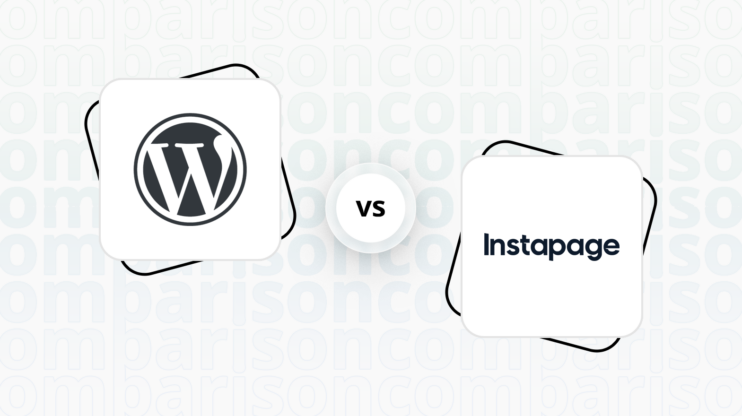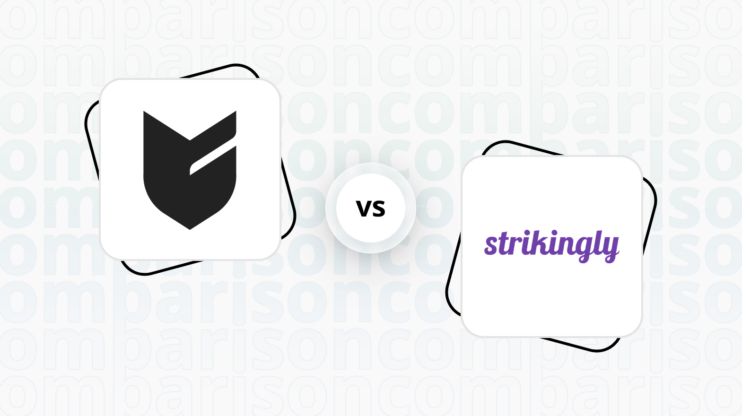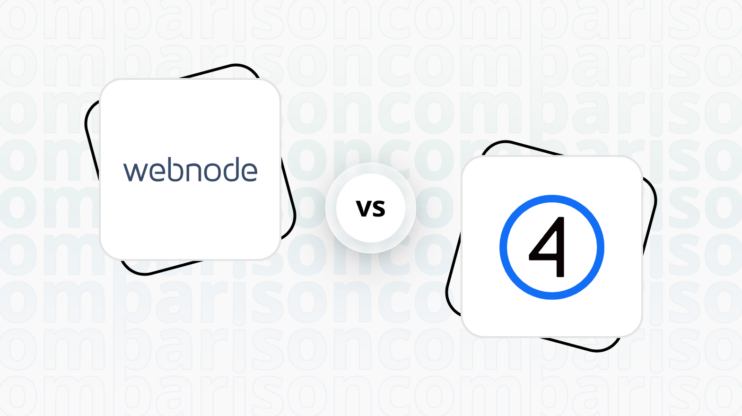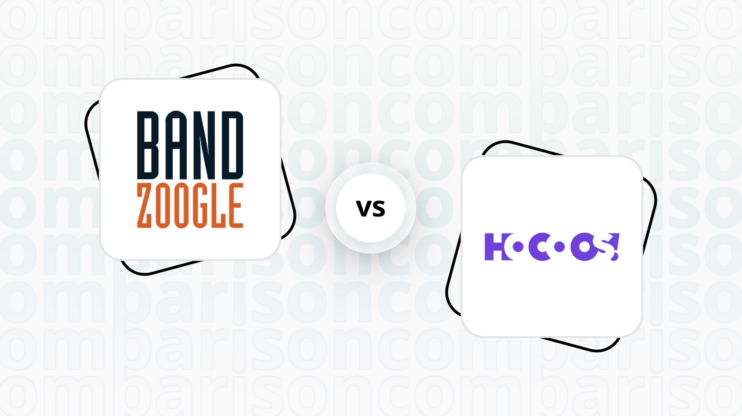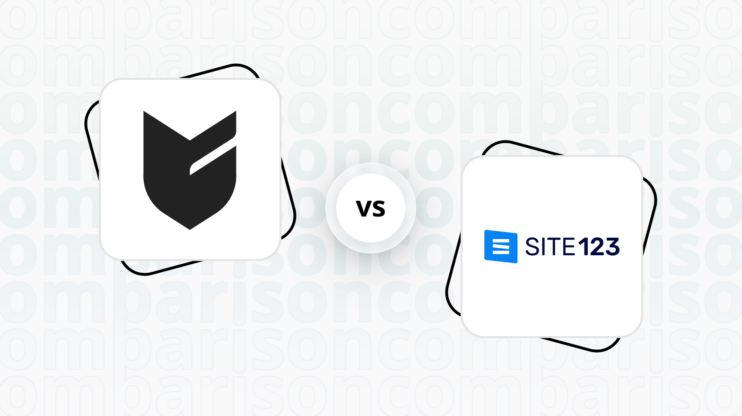Final verdict
Adobe Commerce(ex Magento) and SubHub cater to different needs, making them suitable for distinct user bases.
-
Adobe Commerce(ex Magento) (Overall Grade: 6.9/10)
is a versatile and powerful platform ideal for businesses looking for a comprehensive ecommerce solution. It offers extensive customization options, robust security features, and advanced marketing tools. Adobe Commerce(ex Magento) is best suited for enterprise-level businesses that require scalability and flexibility. However, it demands a higher level of technical expertise, which might be a barrier for smaller businesses or those without dedicated IT resources. -
SubHub (Overall Grade: 5.6/10)
is designed specifically for content creators and entrepreneurs who want to build and manage membership sites. It offers a user-friendly interface, customizable templates, and essential ecommerce features. SubHub is perfect for users who prioritize ease of use and efficiency in setting up subscription models and managing member access. While it lacks the advanced ecommerce capabilities of Adobe Commerce(ex Magento), it provides a straightforward solution for those looking to monetize their content without needing advanced technical skills.

|

|
|
|---|---|---|
|
Design functionalities & templates |
6.7 |
6.8 |
|
Ease of use |
5.4 |
7.7 |
|
Ecommerce |
9.4 |
5.9 |
|
Website Editors |
7.8 |
6.9 |
|
Product testing options |
3.9 |
7.0 |
|
Price |
5.8 |
6.8 |
|
Hosting quality |
8.1 |
5.5 |
|
Website speed optimization |
6.6 |
5.6 |
|
Plugins/extensions and integrations |
9.1 |
5.7 |
|
Marketing features |
8.1 |
5.7 |
|
Customer support |
8.3 |
6.3 |
|
Website security |
8.4 |
4.0 |
|
AI capabilities |
7.7 |
0 |
|
User Management |
8.0 |
5.2 |
Best for ecommerce
 9.4
9.4
 5.9
5.9
Verdict
: Adobe Commerce(ex Magento) is a powerhouse for ecommerce, offering extensive features and scalability, while SubHub is more suited for membership-based businesses with basic ecommerce needs.
-
Adobe Commerce(ex Magento)
: With a score of 9.4, Adobe Commerce is ideal for businesses looking for a robust and scalable ecommerce solution. It offers comprehensive product and inventory management, advanced marketing tools, and seamless payment processing. Its integration with Adobe Experience Cloud provides deep customer insights, making it a top choice for both B2B and B2C businesses. -
SubHub
: Scoring 5.9, SubHub is tailored for content creators and entrepreneurs focusing on membership sites. While it supports basic ecommerce features like physical and digital product listings and pay-per-view content, it lacks the advanced capabilities and scalability of Adobe Commerce. SubHub is best for those who prioritize ease of use and efficiency in managing membership-based businesses.
Best for informational & business websites
 7.4
7.4
 7.2
7.2
Verdict
: Adobe Commerce(ex Magento) and SubHub both offer unique strengths for informational and business websites. Adobe Commerce(ex Magento) is more versatile and powerful, while SubHub is user-friendly and tailored for membership sites.
-
Adobe Commerce(ex Magento)
: Scoring 7.4, Adobe Commerce(ex Magento) is a robust platform that excels in flexibility and scalability. It offers extensive customization options and integrates seamlessly with third-party applications. However, it requires a higher level of technical expertise, making it more suitable for businesses with access to developer resources. Its advanced features and cloud-native solutions make it a strong contender for businesses looking to scale and integrate complex functionalities. -
SubHub
: With a score of 7.2, SubHub is designed specifically for creating and managing membership sites. It offers a range of tools tailored for content creators and entrepreneurs, emphasizing ease of use and efficiency. SubHub simplifies the process of setting up subscription models and managing member access, making it an ideal choice for those looking to build a community and monetize their content. Its user-friendly interface and customizable templates make it accessible for users without advanced technical skills.
Detailed comparison
Design functionalities & templates
Design FunctionalitiesRepresents how well each platform allows for creative design and customization of websites.Score Components:
- Template Variety (30%): Range and quality of design templates.
- Customization (30%): Flexibility and options for design alterations.
- User Interface (20%): Ease and intuitiveness of the design process.
- Responsiveness (10%): Adaptability to different devices and screen sizes.
- Innovation (10%): Unique design features and tools.
 6.7
6.7
 6.8
6.8
🏆
Winner: SubHub.
SubHub slightly edges out Adobe Commerce (ex Magento) in this category, offering a variety of customizable membership website templates and a user-friendly interface that requires no coding skills.
Adobe Commerce (ex Magento) prioritizes flexibility over pre-built templates. While it offers a limited selection of base themes, users can access third-party themes for customization. Theme options are highly adaptable, allowing changes to layouts, colors, fonts, and the creation of custom page layouts.
Adobe Commerce(ex Magento) Themes
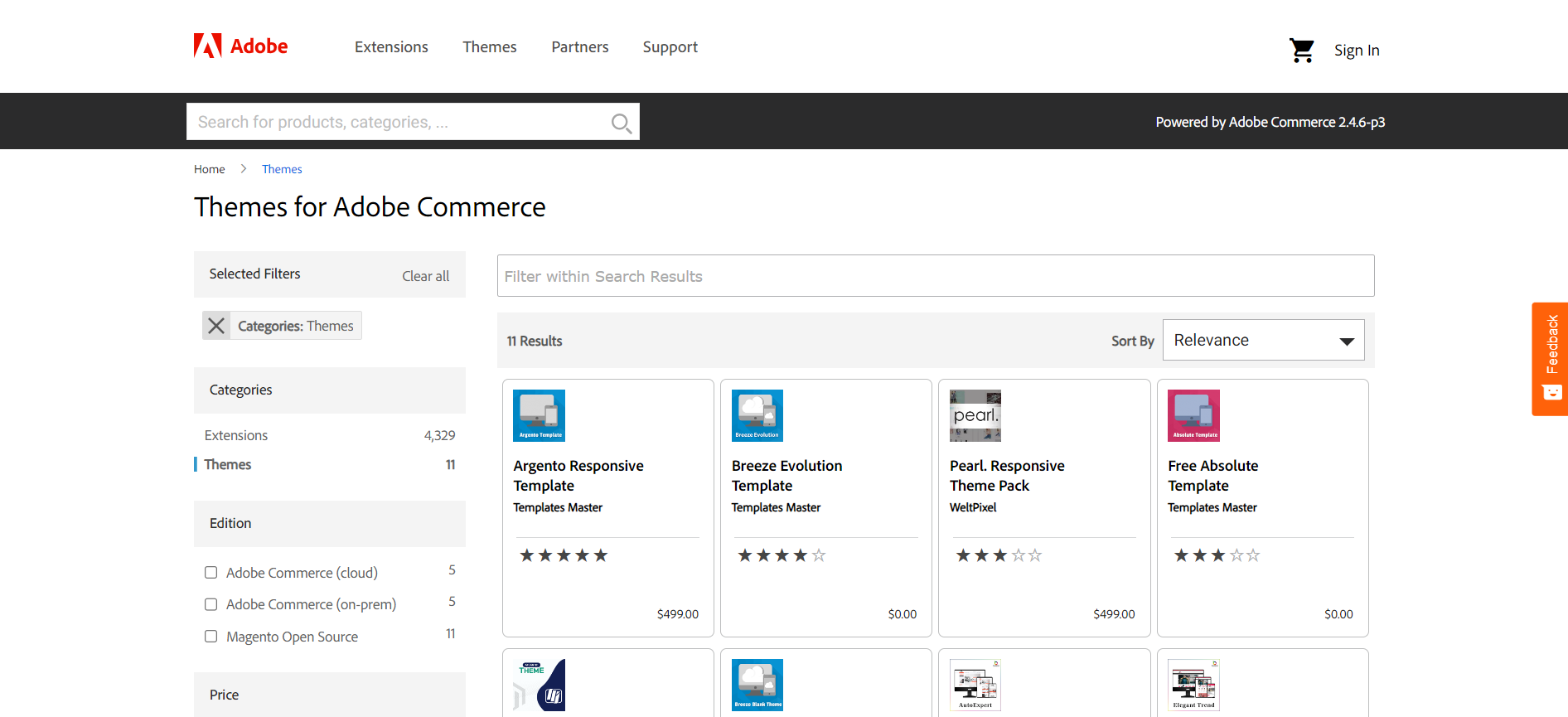
On the other hand, SubHub website builder offers a variety of customizable membership website templates designed to cater to different needs and themes. There are 14 specifically themed templates available, each designed to help users jump-start the design of their membership website homepages.
Get a head start on website creation with AI
Create a custom website tailored to your business needs 10X faster with 10Web AI Website Builder!
Ease of use
Ease of useReflects the platform’s overall user-friendliness.Score
Components:
- Learning curve (40%): Quickness and ease of getting started.
- Interface design (30%): Simplicity and intuitiveness of layout.
- User guidance (20%): Quality of tutorials and support.
- Flexibility (10%): Adaptability to various user skills.
 5.4
5.4
 7.7
7.7
🏆 Winner: SubHub
. Scoring a 7.7, SubHub is designed with ease of use in mind, making it an ideal choice for content creators and entrepreneurs who want to build a community and monetize their content. Adobe Commerce(ex Magento), with a score of 5.4, offers a versatile commerce platform but requires a higher level of technical expertise, making it more suitable for enterprise-level businesses.
Learning Resources
🏆 Winner: Adobe Commerce(ex Magento)
. Adobe Commerce(ex Magento) offers a comprehensive array of learning resources, including videos, tutorials, and instructor-led courses, covering everything from basic store management to advanced catalog and product management. SubHub also provides a range of learning resources, including video guides and tutorials, but Adobe Commerce(ex Magento)’s resources are more extensive.
For ecommerce
EcommerceMeasures the platform’s effectiveness in supporting online business activities.Score Components:
- Ecommerce themes and templates (20%): Variety and design of templates.
- Product management (25%): Ease of managing and organizing products.
- Payment options (25%): Variety and convenience of payment methods.
- Ecommerce features (20%): Features for managing an ecommerce store.
- Integration (10%): Compatibility with external e-commerce tools and services.
 9.4
9.4
 5.9
5.9
Adobe Commerce (ex Magento) is a robust ecommerce platform that offers a comprehensive set of features such as product and inventory management, efficient order processing, customer account management, targeted marketing capabilities, diverse payment processing options, robust security measures, and scalability to accommodate business growth. On the other hand, SubHub, while designed specifically for creating and managing membership sites, supports various e-commerce features including sales of physical goods, digital products, and pay-per-view content, with a customizable storefront and product categories. However, it lacks support for distributing free products and does not manage the dispatch of physical goods, potentially requiring sellers to handle their shipping logistics.

|

|
|
|---|---|---|
|
Ecommerce themes and templates |
7.5 |
3.0 |
|
Product page customization |
9.0 |
6.5 |
|
Payment processing and commissions |
7.8 |
7.0 |
|
POS capabilities |
7.0 |
0.0 |
|
Payment gateways |
8.5 |
6.0 |
|
Product numbers |
7.5 |
5.0 |
|
Additional ecommerce features |
8.0 |
4.5 |
Adobe Commerce (ex Magento) ecommerce features:
- Product and Inventory Management
- Order Management
- Customer Management
- Marketing and Promotions
- Payment Processing
- Multi-Channel Commerce
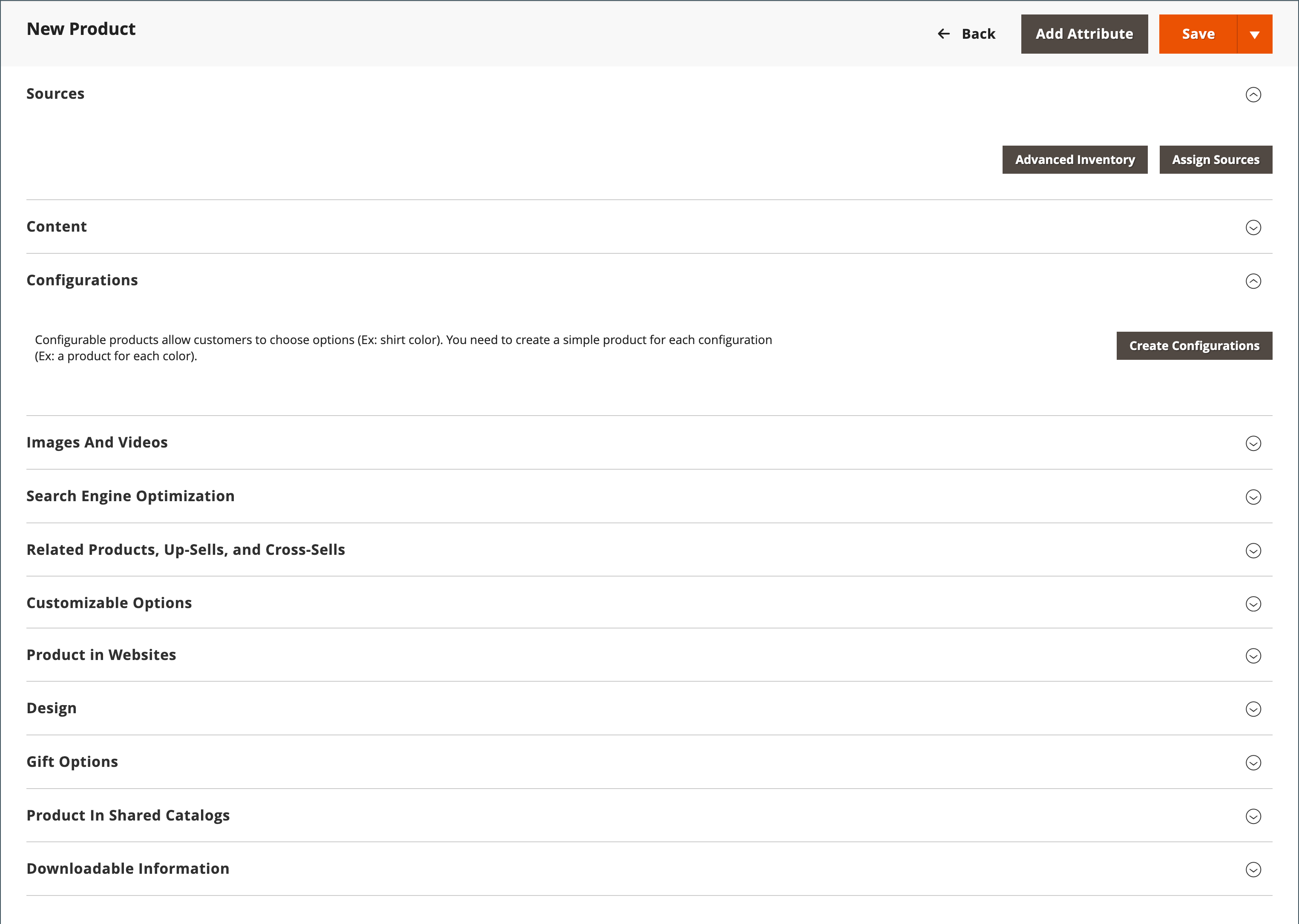
SubHub ecommerce features:
- Paypal and Stripe integration
- Physical and Digital product listings
- Pay-per view products
Ecommerce themes & templates
Adobe Commerce, powered by Magento, offers a comprehensive ecosystem for ecommerce themes and templates, enabling businesses to customize their online stores to meet specific branding and functionality requirements. Themes in Adobe Commerce serve as the visual and structural framework for online stores, incorporating layout files, template files, translation files, and skins to define the look and feel. On the other hand, SubHub does not offer ecommerce specific templates.
Product page customization
Adobe Commerce offers extensive customization options for product pages, enabling businesses to enhance the user experience and tailor product displays to their specific needs. This includes customizing layouts, product attributes, images and media, dynamic content like related products and reviews, and custom product options such as configurable and bundled products. SubHub, on the other hand, offers a range of product page customization options, allowing for the addition of physical items, digital downloads, and pay-per-view content. Features include the ability to manage product variants, upload images, and set visibility preferences. Users can also implement SEO strategies through meta tags and manage tax settings.
Payment processing
Adobe Commerce offers integrated payment solutions and commission management for seamless online transactions, alongside POS integration for omnichannel retail experiences. It supports a wide array of payment gateways, ensuring flexible and secure payment options for customers. SubHub supports two main payment gateways: Stripe and PayPal, allowing for secure payment processing for subscriptions and store items using debit or credit cards. The platform itself does not charge commissions on transactions.
Website Editors
Website EditorsEvaluates the platforms’ website building and editing capabilities.Score Components:
- Customization tools (40%): Range and power of editing features.
- Editor usability (30%): User experience within the editor.
- Design flexibility (20%): Freedom in layout and design changes.
- Update and maintenance ease (10%): Simplicity of updating and maintaining the site.
 7.8
7.8
 6.9
6.9
🏆
Winner: Adobe Commerce(ex Magento)
. Adobe Commerce, with a score of 7.8, offers a user-friendly website editor with its Page Builder tool, designed for ease of use through drag-and-drop capabilities, allowing for simple management and customization of eCommerce sites without extensive developer involvement. It provides a flexible and intuitive platform for users to effortlessly design, update, and maintain their online stores, supported by a variety of design options and themes for tailored branding and promotional activities.
SubHub’s editor, scoring 6.9, offers a user-friendly website builder tailored for creating and managing membership sites, catering to content creators and entrepreneurs aiming to monetize their offerings. Its features encompass customizable templates, diverse content publishing options, and flexible subscription plans with seamless integration for recurring revenue through payment processors. Additionally, SubHub supports online course creation, provides marketing tools like landing page builders, and offers detailed analytics for monitoring website metrics.
Mobile editor/app
 0
0
 4.0
4.0
🏆
Winner: SubHub
. Neither Adobe Commerce (ex Magento) nor SubHub offer a dedicated mobile app for website editing. However, SubHub allows users to manage some content on their website using the mobile browser version, albeit without the ability to change the layout and design of the website. On the other hand, Adobe Commerce does not offer any mobile editing capabilities at this time.
Therefore, SubHub is the winner in this category, albeit with limited functionality.
Product testing options
Product Testing OptionsAssesses the options for trying out platform features before commitment.Score Components:
- Trial quality (40%): Extent and usefulness of the trial or free version.
- Feature accessibility (30%): How many features are available to test.
- Trial duration (20%): Length of the trial period.
- Ease of transition (10%): Smoothness of moving from trial to paid plans.
 3.9
3.9
 7.0
7.0
Overall Result
:
SubHub Wins
. SubHub scores 7.0, significantly higher than Adobe Commerce(ex Magento) with a score of 3.9. SubHub offers a 14-day free trial, during which users can test premium features. Additionally, SubHub provides a 7-day money-back guarantee. On the other hand, Adobe Commerce(ex Magento) does not offer a free or trial version, but users can request a demo version to test premium features. However, it does not provide a money-back guarantee.

|

|
|
|---|---|---|
|
Free Plan |
No | No |
|
Trial Duration |
No |
14 days |
|
Testing Premium Features |
Request a demo version |
During the free trial |
|
Money Back Guarantee |
No |
7 days |
Price
PriceLooks at the cost-effectiveness and value for money of each platform.Score Components:
- Plan value (40%): What each pricing tier offers.
- Transparency and clarity (30%): Clearness of pricing structures.
- Flexibility of plans (20%): Range of options to suit different budgets.
- Hidden costs (10%): Additional expenses not included in the plan.
 5.8
5.8
 6.8
6.8
Adobe Commerce(ex Magento) is a premium solution with pricing starting from approximately $2,000, while SubHub offers more affordable options starting from $47 per month.

|

|
|
|---|---|---|
|
$40-$50 |
No offering at this amount. |
Starter ($47/month): Up to 500 members, 5 GB storage, secure payment processing, course builder, 5 landing pages, e-commerce. Value for price: 6.5 |
|
$90-$100 |
No offering at this amount. |
Pro ($97/month): Up to 2000 members, 50 GB storage, removes SubHub branding, 15 landing pages, along with Starter features. Value for price: 7.5 |
|
$100-$200 |
No offering at this amount. |
Premium ($147/month): Unlimited members, 200 GB storage, email white labelling, 30 landing pages, plus all Pro features. Value for price: 8.5 |
|
$2000+ |
Adobe Commerce Pro and Managed Services ($2000/month): Adobe Commerce Pro and Managed Services are designed to deliver scalable, secure, and extensive eCommerce solutions tailored to a wide range of business demands. It offers a comprehensive set of ecommerce tools, including product and inventory management, efficient order processing, customer account management, targeted marketing capabilities, diverse payment processing options, robust security measures, and scalability to accommodate business growth. It also offers both self-hosted and cloud-hosted options, providing flexibility and optimized performance. While it does not have an AI website builder, it offers a powerful theme framework for comprehensive control, including frontend editing for basic adjustments. Experienced developers can employ custom code for unique designs and advanced functionalities. |
No offering at this amount. |
location. As a result in rare cases the prices displayed here can differ from the ones you see on their
websites.
Hosting quality
Hosting
qualityExamines the reliability and performance of the hosting solutions.Score Components:
- Uptime (40%): Consistency and reliability of website availability.
- Speed (30%): Loading times and performance.
- Bandwidth and storage (20%): Sufficiency of resources provided.
- Data centers (10%): Quality and distribution of hosting infrastructure.
 8.1
8.1
 5.5
5.5
Winner: Adobe Commerce(ex Magento)
Adobe Commerce offers robust and scalable eCommerce solutions with both self-hosted and cloud-hosted options, providing flexibility and optimized performance. SubHub, on the other hand, offers managed cloud hosting with storage limitations depending on the plan. Adobe Commerce’s hosting quality score is higher, making it the winner in this category.

|

|
|
|---|---|---|
|
Do they offer hosting? |
Yes, Adobe Commerce offers robust and scalable eCommerce solutions with both self-hosted and cloud-hosted options, providing flexibility and optimized performance through technologies like Fastly Image Optimization. | Yes, from 5GB to 200GB storage limitation depending on the plan and daily backups. |
|
Data Centers: |
Adobe Commerce on Cloud infrastructure Leverages Amazon Web Services (AWS), Specific data center details not publicly available | Subhub does not disclose the locations of its data centers |
|
Type of hosting: |
Self Hosting, Managed Hosting | Managed Cloud Hosting |
|
Uptime: |
Uptime Guarantee for Adobe Managed hosting is provided | Subhub does not provide uptime statistics or guarantees |
Website Speed Optimization
Website Speed OptimizationEvaluates optimization of website loading timesScore Components:
- PageSpeed Score (30%): Google’s score indicating performance optimization.
- Loading Time (30%): The average time until a website is fully interactive.
- Mobile Optimization (15%): Optimization effectiveness for mobile devices.
- Resource Optimization (15%): Optimizing images, scripts, and other heavy resources.
- CDN Usage (10%): Use of CDN to enhance speed across geolocations.
 6.6
6.6
 5.6
5.6
🏆 Winner: Adobe Commerce(ex Magento)
Both Adobe Commerce(ex Magento) and SubHub prioritize website performance and page speed, but Adobe Commerce(ex Magento) provides more detailed information about its strategies for speed optimization and Core Web Vital improvements.

|

|
|
|---|---|---|
|
Focus |
CDN, Database optimization, Caching, Indexing |
Image Optimization, Caching, Mobile Optimized design |
|
Performance Tools |
Google Lighthouse, PageSpeed Insights |
Google PageSpeed Insights Integration |
|
Key Strategies |
CDN, Database optimization, Caching, Indexing |
Image Optimization, Caching, Mobile Optimized design |
|
Load Times |
Varies widely, dependent on optimization |
Varies depending on optimization and website complexity |
|
Page Speed Scores Range |
Scores vary; influenced by plugins, images |
Varies depending on optimization and website complexity |
|
Core Web Vitals Improvement |
Emphasis on LCP, FID, CLS improvements |
No information provided |
Adobe Commerce(ex Magento) focuses on enhancing site speed through CDN, database optimization, caching, and indexing. It places a strong emphasis on improving Core Web Vitals, particularly LCP, FID, and CLS. The load times and PageSpeed scores vary widely, depending on the level of optimization and the use of plugins and images.
SubHub, on the other hand, focuses on image optimization, caching, and mobile-optimized design for speed optimization. However, it does not provide any information on their Core Web Vitals improvements. The load times and PageSpeed scores vary depending on the level of optimization and the complexity of the website.
Get a head start on website creation with AI
Create a custom website tailored to your business needs 10X faster with 10Web AI Website Builder!
Plugins and integrations
Plugins and integrationsMeasures the range and effectiveness of additional plugins and integrations.Score Components:
- Variety of options (40%): Range of available add-ons.
- Integration smoothness (30%): Ease of integrating plugins into the site.
- Quality of plugins (20%): Functionality and reliability of the options.
- Custom integration capabilities (10%): Support for custom or third-party integrations.
 9.1
9.1
 5.7
5.7
🏆 Winner: Adobe Commerce(ex Magento).
Adobe Commerce(ex Magento) scores a high 9.1, offering a vast array of extensions and plugins, estimated to be in the tens of thousands, covering aspects such as marketing, payment processing, shipping, content management, security, and optimization. This makes it a powerful platform for creating tailored ecommerce experiences. On the other hand, SubHub, with a score of 5.7, offers a set of built-in features and limited third-party integrations primarily with MailChimp, Google Analytics, and payment gateways like Stripe and PayPal. While Subhub provides a comprehensive toolkit for creating and managing membership sites, its range of external integrations might be seen as limited compared to Adobe Commerce(ex Magento).
Adobe Commerce(ex Magento) Applications
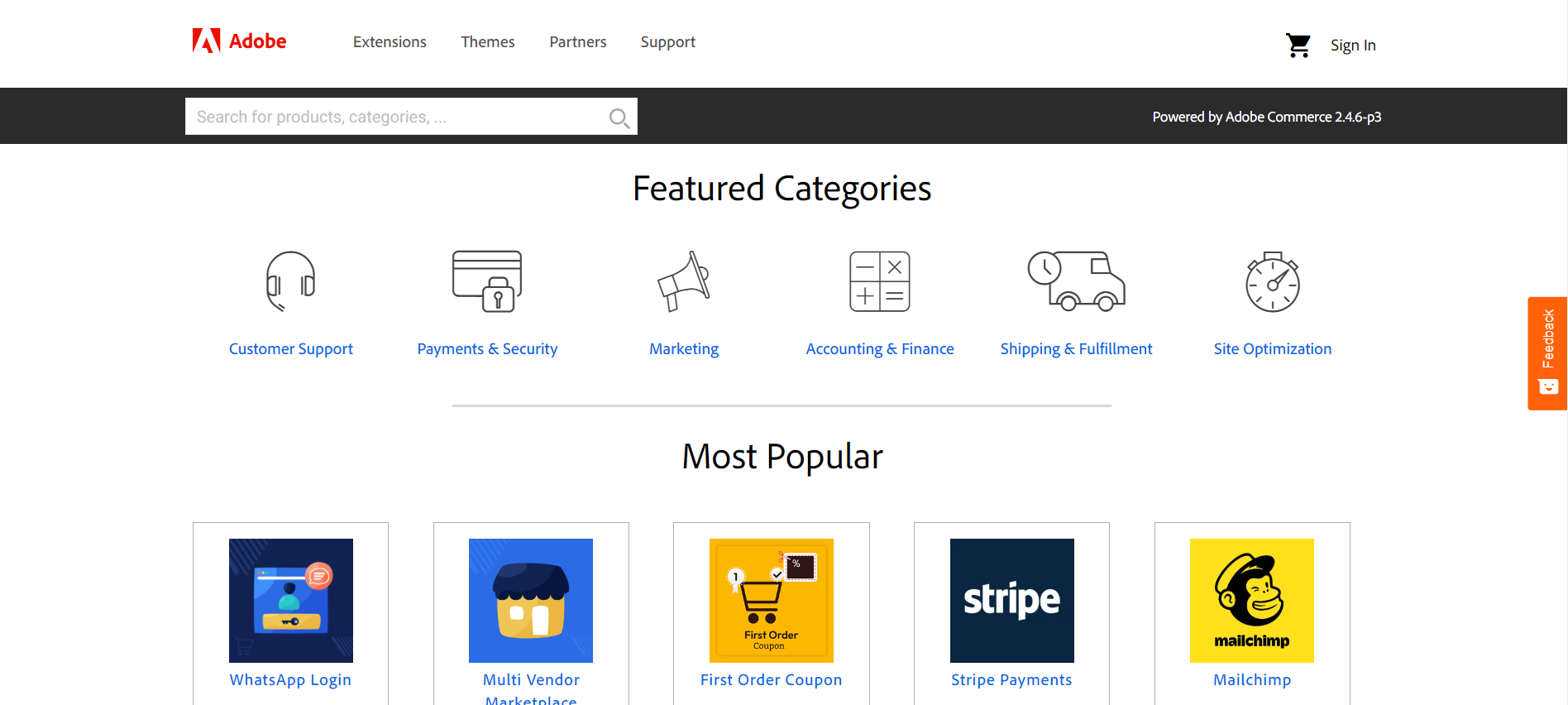
Marketing Features
Design FunctionalitiesRepresents how well each platform allows for creative design and customization of websites.Score Components:
- Template Variety (30%): Range and quality of design templates.
- Customization (30%): Flexibility and options for design alterations.
- User Interface (20%): Ease and intuitiveness of the design process.
- Responsiveness (10%): Adaptability to different devices and screen sizes.
- Innovation (10%): Unique design features and tools.
 8.1
8.1
 5.7
5.7
🏆
Overall Winner: Adobe Commerce(ex Magento)
. Adobe Commerce(ex Magento) offers a more comprehensive set of marketing features, especially in terms of social media integration and advanced promotional tools. SubHub, on the other hand, lacks social media integration and has basic promotional tools.

|

|
|
|---|---|---|
|
SEO Tools |
|
|
|
Email Marketing |
|
|
|
Blogging |
Can be integrated with platforms like WordPress for content marketing purposes. |
|
|
Social Media Integration |
|
|
|
Analytics and Reporting |
Adobe Commerce integrates with Google Analytics and other analytics tools, providing detailed insights into your ecommerce activities. |
Basic analytics for website traffic and engagement |
|
Ads and Promotions |
Advanced marketing tools for creating and managing promotions, coupons, and personalized content. |
Basic promotional tools |
Customer Support
Customer supportEvaluates the quality and availability of support options.Score Components:
- Response time (40%): Speed of support responses.
- Support quality (30%): Effectiveness and helpfulness of the support.
- Availability (20%): Range of support channels (phone, chat, email).
- Resource richness (10%): Quality of self-help and educational materials.
 8.3
8.3
 6.3
6.3
🏆 Winner: Adobe Commerce(ex Magento)
. When comparing Adobe Commerce(ex Magento) vs SubHub, Adobe Commerce(ex Magento) stands out with its comprehensive 24/7 customer support through phone, email, and live chat. It also offers a robust knowledge base, community forums, and extensive documentation, ensuring users have multiple avenues for assistance. For enterprise users, Adobe Commerce provides dedicated account management and access to a global network of experts, enhancing its support capabilities.
SubHub, on the other hand, offers customer support primarily through email and a support portal for detailed queries. While it includes an FAQ section for quick answers, it lacks the 24/7 availability and extensive resources that Adobe Commerce provides. Additionally, SubHub does not offer specialized support for enterprise-level businesses, making Adobe Commerce the more robust option for comprehensive customer support.
Security
SecurityLooks at the platforms’ security measures and data protection.Score Components:
- Data protection (40%): Safeguards for user and customer data.
- SSL and encryption (30%): Implementation of secure connections.
- Compliance (20%): Adherence to industry security standards.
- Regular updates (10%): Frequency of security updates and patches.
 8.4
8.4
 4.0
4.0
🏆
Winner: Adobe Commerce(ex Magento)
. Adobe Commerce (ex Magento) takes security seriously, providing advanced encryption, access control measures, regular security updates, and secure payment processing to protect customer data. This ensures that sensitive information is kept safe from unauthorized access or breaches.
SubHub, while emphasizing compliance with GDPR and CCPA regulations in its privacy policy, does not provide specific information about its website security measures. This lack of transparency may be a concern for users who prioritize security in their website builder choice.
AI Capabilities
AI capabilitiesMeasures the effectiveness of AI-driven features and tools.Score Components:
- Automation efficiency (40%): Impact of AI on streamlining processes.
- Personalization (30%): AI-driven customization for users or customers.
- AI-Assisted design (20%): Role of AI in website design and functionality.
- Data analysis (10%): Use of AI in interpreting user data and analytics.
 7.7
7.7
 0
0

|

|
|
|---|---|---|
|
Personalized Design |
|
|
|
SEO Optimization |
AI-driven recommendations for better search engine visibility |
|
|
Customer Behavior Analysis |
Advanced analytics to understand customer preferences |
|
|
Sales Predictions |
AI-powered sales forecasting tools |
|
|
Inventory Management |
AI tools to assist in efficient inventory handling |
|
|
Content Generation |
AI assistance in creating and optimizing site content |
|
🏆 Winner: Adobe Commerce (ex Magento)
. Adobe Commerce, with a score of 7.7, utilizes AI to enhance the eCommerce experience, streamline content creation, and improve customer service, security, and marketing. Its AI features focus on customer behavior analysis, personalized shopping experiences, inventory management, and sales predictions.
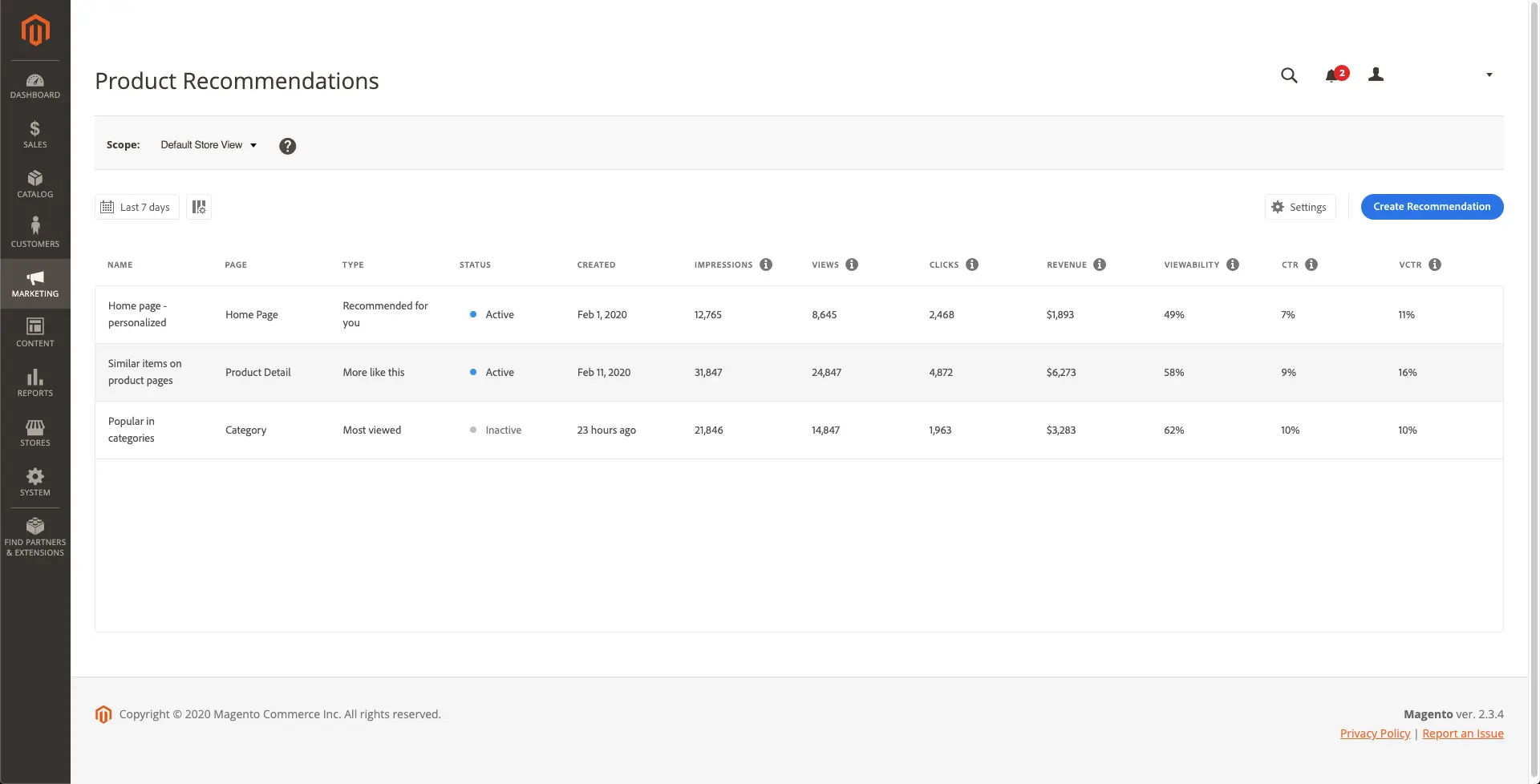
SubHub, on the other hand, does not have any AI capabilities. This lack of AI features may limit the platform’s ability to provide personalized experiences and efficient operations, particularly for larger or more complex sites.
User Management
User ManagementAssesses the platforms’ capabilities in managing user roles, permissions, and accessibility.Score Components:
- Role Customization (40%): Flexibility in creating and defining user roles and
permissions. - Ease of Management (30%): User interface and tools for managing users.
- Access Control (20%): Effectiveness of access control measures for different user
levels. - Scalability (10%): Ability to manage a growing number of users efficiently.
 8.0
8.0
 5.2
5.2
🏆 Winner: Adobe Commerce(ex Magento)
. Adobe Commerce(ex Magento) and SubHub offer different approaches to user management.
- Adobe Commerce(ex Magento) allows a number of users to edit a website based on user licenses and roles. User licenses, which are bought separately, determine the total number of users allowed, with additional licenses purchasable as needed. Roles and permissions, managed within the available licenses, control access and modifications, ensuring data security and efficient workflow.
- SubHub allows multiple user accounts, however the platform does not specify how many accounts are supported.
Adobe Commerce(ex Magento) User Roles and Access Levels:
| Role | Description | Access Highlights |
|---|---|---|
| Administrator | Has full permissions to all aspects of Adobe Commerce, including global settings and data. | Full access to all settings, data, and functionalities within Adobe Commerce. Can manage other users’ roles and permissions. |
| Store Administrator | Responsible for the day-to-day management of the store, including products, orders, and customer service. | Access to manage products, process orders, and handle customer inquiries, but may have restricted access to sensitive global settings or data. |
| Design Team Member | Focuses on the aesthetic and user experience aspects of the store, working on content design and layout. | Access to content design tools and functionalities, but restricted from accessing customer, order information, and other sensitive areas. |
| Default User (B2B) | Has view-only access to company profile and credit information, and full access to activities related to sales and quotes. | Full access to sales and quotes activities; view-only for company profile and credit information. |
| Senior Buyer (B2B) | Engaged in purchasing, with access to all Sales and Quotes resources, and view-only permissions to the Company Profile, User and Teams, Payment Information, and Company Credit. | Comprehensive access to Sales and Quotes, with limited viewing rights for company’s financial and profile data. |
| Assistant Buyer (B2B) | Assists in purchasing activities, with permissions to place orders using Checkout with Quote, and to view orders, quotes, and company profile information. | Permission to execute orders and access relevant purchasing data; view-only access to company profile information. |
SubHub User Roles and Access Levels:
| Role | Description | Access Highlights |
|---|---|---|
| Administrator | Full access to the platform except for Homepage and Course Editor. | Can manage all aspects of the platform, including content, store, and member management. |
| Content Management | Focuses on managing and organizing content within the platform. | Can access and manage content-related features but does not have access to Homepage or Course Editor. |
| Store (access only) | Specializes in handling the platform’s store features. | Limited to store management functions; no access to Homepage, Course Editor, or member management. |
| Member Manager (access only) | Oversees member accounts, roles, and subscriptions. | Can manage members and their subscriptions but cannot access Homepage, Course Editor, or store management. |
| *Origin Admin Email | The initial administrator with the highest level of access, including Homepage and Course Editor. | Exclusive access to Homepage and Course Editor, on top of what the Administrator role provides. |
Additional Features

|

|
|
|---|---|---|
|
SSL Certificate |
|
|
|
Custom Domain |
|
|
|
Free Custom Domain Included |
|
|
|
International Domains |
|
|
|
Mobile Responsive |
|
|
|
Page Speed |
|
|
|
Website Builder Mobile App |
|
|
|
Convert a Website To An App |
|
|
|
Website Analytics |
|
|
|
Multilingual Sites |
|
|
|
Multiple Users |
|
|
User Feedback
Adobe Commerce (formerly Magento Commerce) receives high praise for its comprehensive ecommerce solutions, offering features like customer and order management, scalability, and customization options. Users appreciate its flexibility and ease of use, although some mention a learning curve due to its extensive features. Despite occasional drawbacks like slow speed or complexity, Adobe Commerce proves beneficial for businesses seeking robust ecommerce platforms, aiding in sales growth, customer management, and overall efficiency in managing online stores.
User feedback on SubHub presents a mix of positive and negative experiences, emphasizing the platform’s feature-rich environment and customizable templates. Users appreciate the flexibility and the quality of customer service, highlighting the platform’s continual updates and support as key benefits. However, some users express dissatisfaction with aspects such as the platform’s interface, lack of community features, and service fees for ticket resale. Concerns were also raised about the custom design service and mobile-friendly solutions taking longer than expected.
The making of this blog
We followed a clear, step-by-step process to write and research this article.
FAQ
Which platform is better for ecommerce, Adobe Commerce (ex Magento) or SubHub?
Can I use SubHub for selling products or is it just for memberships?
Is Adobe Commerce (ex Magento) suitable for beginners?
How do the pricing models of Adobe Commerce (ex Magento) and SubHub compare?
Which platform offers better customer support, Adobe Commerce (ex Magento) or SubHub?
Are there any AI capabilities in SubHub similar to Adobe Commerce (ex Magento)?










